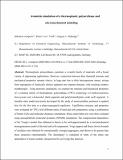Atomistic Simulation of a Thermoplastic Polyurethane and Micromechanical Modeling
Author(s)
Lempesis, Nikolaos; in ‘t Veld, Pieter J.; Rutledge, Gregory C
DownloadAccepted version (11.28Mb)
Publisher Policy
Publisher Policy
Article is made available in accordance with the publisher's policy and may be subject to US copyright law. Please refer to the publisher's site for terms of use.
Terms of use
Metadata
Show full item recordAbstract
Thermoplastic polyurethanes constitute a versatile family of materials with a broad variety of engineering applications. However, connection between their chemical structure and mechanical properties remains elusive, in large part due to their heterogeneous nature, arising from segregation of chemically distinct segments into separate domains, with resulting complex morphologies. Using atomistic simulations, we examine the structure and mechanical properties of a common family of thermoplastic polyurethanes (TPU) comprising 4,4′-diphenylmethane diisocyanate and n-butanediol (hard segment) and poly(tetramethylene oxide) (soft segment). A lamellar stack model previously developed for the study of semicrystalline polymers is applied here for the first time to a phase-segregated copolymer. Equilibrium structure and properties were evaluated for TPUs with different ratios of hard and soft components, using a combination of Monte Carlo and molecular dynamics simulations. Stress-strain behaviors were then evaluated using nonequilibrium molecular dynamics (NEMD) simulations. The compositional dependence of the Young's moduli thus obtained is shown to be well-approximated by a micromechanical homogenization model of the hard and soft components. Voigt (upper) and Reuss (lower) bounds of modulus were obtained for orientationally averaged aggregates and shown to be greater than those measured experimentally. The discrepancy is explained in terms of the strain rate dependence of elastic moduli, characterized by an Eyring-like function.
Date issued
2017-09Department
Massachusetts Institute of Technology. Department of Chemical EngineeringJournal
Macromolecules
Publisher
American Chemical Society (ACS)
Citation
Lempesis, Nikolaos et al. "Atomistic Simulation of a Thermoplastic Polyurethane and Micromechanical Modeling." Macromolecules 50, 18 (September 2017): 7399–7409 © 2017 American Chemical Society
Version: Author's final manuscript
ISSN
0024-9297
1520-5835